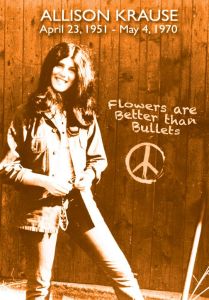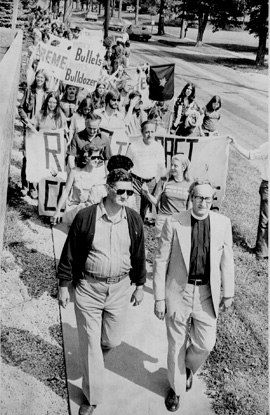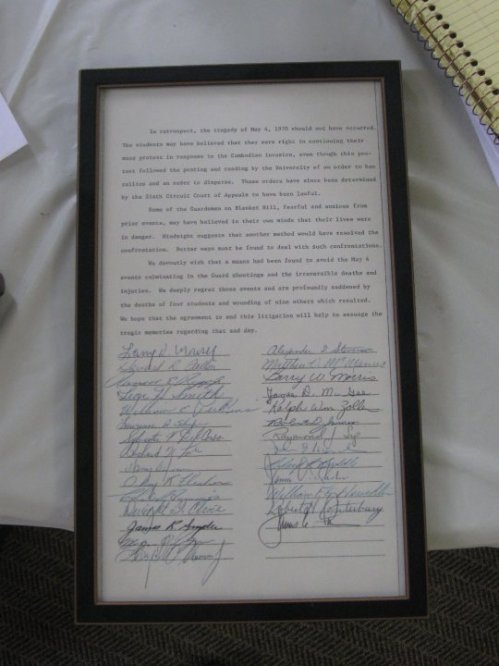How a 37-year-old telegram to the President was saved from the dustbin of history
 By Shane Harris, published on June 1, 2012 in the The Washingtonian.
By Shane Harris, published on June 1, 2012 in the The Washingtonian.
September 8, 1974, was an especially chaotic day at the White House. That was the day that Gerald Ford, barely a month into his term as President, gave Richard Nixon a full pardon for any crimes he may have committed in connection with the Watergate scandal. Ford’s decision was widely criticized, and the White House was flooded with angry reactions from the public. One of them came from Arthur Krause.
Krause’s daughter Allison was killed at Kent State University on May 4, 1970, when National Guard members opened fire on students protesting Nixon’s decision to invade Cambodia. Upon learning of the pardon, Krause went to a Western Union office near his home in Pittsburgh and fired off a telegram to Ford. It read, in part: “You pardoned Nixon because you believe he and his family have suffered enough. My wife and I lost our daughter Allison [ . . . ] due to actions and words of Nixon.”
Krause was of the opinion—one not shared by many Nixon historians—that the former President was personally responsible for the shootings. He wrote that Nixon had given the National Guard the “right to kill,” and he said the President and his senior staff had tried to block the convening of a federal grand jury. Ford’s pardon covered “all offenses against the United States,” not just those related to Watergate, so any hope Krause may have had for seeing Nixon prosecuted vanished with the stroke of the President’s pen.
Addressing Ford directly, Krause wrote, “Sir, you are less a man today than you were yesterday.” Krause signed the telegram along with his wife, Doris.
The telegram arrived at the White House, where normally it would have been answered by staff on the President’s behalf and then filed with other documents about the Nixon pardon. But Krause’s emotional message caught the eye of Roland Elliott, the White House director of correspondence, who thought it deserved more than a form-letter reply.
Elliott passed the telegram to George P. “Skip” Williams, an associate counsel to the President, with a note: “Hasn’t the Kent State case been reopened by Justice?” Elliott seemed to be hoping the White House could update Krause on whether the Justice Department had any new information on the events that led to the death of his daughter and three other students. Elliott put a red tag on his memo, indicating that Williams should give the question high priority.
But the question was never answered. And Ford never replied to Krause’s telegram. It was placed in a file of unanswered mail, and it sat there for the next 37 years.
The story would have ended there, if not for a meticulous, eagle-eyed archivist named William H. McNitt, who spends his days combing through thousands of pages of memos, correspondence, presidential schedules, and other documents at the Gerald R. Ford Presidential Library and Museum, in Ann Arbor, Michigan. On February 15, 2012, McNitt was conducting what he calls a “systematic review of previously unreviewed portions of the collection” — the historian’s equivalent of panning for gold — and he came across Box 82 from the records of a staffer in the White House Counsel’s Office. Inside was a folder labeled “Unanswered Mail, September 1974 (1).” Most archivists pass over these orphaned records, McNitt says. But he opened the folder, and inside he saw Krause’s telegram. He immediately grasped its significance.
McNitt traced the path of the old document, which still bears faint pencil marks made by a White House staffer who underlined “my wife and I lost our daughter . . .” He followed the note from Elliott to Williams, and concluded that the correspondence must have gotten lost in the chaos surrounding the Nixon pardon. “Williams and the rest of the staff in the Counsel’s Office were overwhelmed with work,” McNitt says, “and never got around to responding.”
The Ford Library gave a copy of the telegram to The Washingtonian, and we got in touch with Laurel Krause, Allison’s sister. Reached by phone at her home in California one morning, Krause, who never knew her father wrote the telegram, welled up as the text was read to her.
“That’s my dad!” she said, delighted, and at the same time a little shocked and sad. At the time of the Nixon pardon, Laurel says she was working on the Hill, as an intern for Senator Ted Kennedy. She recalls that on the day a month earlier when the Senate interns were supposed to hear a speech from then Vice President Ford, he had to cancel, because he was being sworn in as president.
Laurel says that after her sister died, her father began to investigate the events of that day in May 1970. He has since died, but Laurel has continued the cause. She cofounded the Kent State Truth Tribunal, which has collected information and testimony about the shootings and has petitioned President Obama and Attorney General Eric Holder to reexamine the case.
Laurel’s father never heard back from President Ford. But as it happens, McNitt, the former President’s tireless archivist, may have some answers for the Krause family after all.
The question Elliott had asked about the Justice Department’s investigation is answered, McNitt says, by another collection in the library. It resides among the papers of another Ford-era official, J. Stanley Pottinger, who served as the Assistant Attorney General for the Civil Rights Division. Pottinger had also worked in the Department of Health, Education, and Welfare. In his records, McNitt found approximately 2,000 pages of documents about an examination of the shootings by both the departments where Pottinger had worked. The government almost certainly relied on that information to bring an indictment in March 1974 against eight National Guardsmen. A trial began in October, the month after Ford pardoned Nixon. A judge directed a verdict of acquittal in November.
And McNitt found something else. In those 2,000 pages are records of “a number of telephone messages to Pottinger from Arthur Krause concerning the investigation of his daughter’s death.” Maybe Krause’s insistence helped push the government to seek justice for Allison.
And so, nearly four decades later, Arthur Krause has some measure of response. It’s not in the form of a letter from the President, which we now know the White House felt Krause deserved. The response comes instead from a quiet, diligent archivist, who stopped to open an unremarkable box and sensed a moment in history, and a family in pain.
View the PDF for the full telegram.
 Last month on May 22, 2019 we witnessed a significant ‘turning of the tide’ for Kent State truth in the May 4, 1970 Kent State massacre.
Last month on May 22, 2019 we witnessed a significant ‘turning of the tide’ for Kent State truth in the May 4, 1970 Kent State massacre. Good Afternoon. I’d like to thank May 4th Task Force for having me here with you today.
Good Afternoon. I’d like to thank May 4th Task Force for having me here with you today. Soon I shall come to Henry Kissinger and David Frost and William Shawcross and all the rest who are arguing about what America did or did not do in Cambodia. First, though, I want to say something about a girl named Allison Krause. She deserves to be mentioned.
Soon I shall come to Henry Kissinger and David Frost and William Shawcross and all the rest who are arguing about what America did or did not do in Cambodia. First, though, I want to say something about a girl named Allison Krause. She deserves to be mentioned. Now, once again, I’m looking for her picture. It’s on my desk along with newspaper clippings about Cambodia and the book, “Sideshow” by William Shawcross and all the stuff about Henry Kissinger and David Frost. They have been arguing, the three of them, about who was responsible for what – everything from the secret bombings of Cambodia back to 1969 to the sad state of the country today. Once again, Kissinger is winning the debate.
Now, once again, I’m looking for her picture. It’s on my desk along with newspaper clippings about Cambodia and the book, “Sideshow” by William Shawcross and all the stuff about Henry Kissinger and David Frost. They have been arguing, the three of them, about who was responsible for what – everything from the secret bombings of Cambodia back to 1969 to the sad state of the country today. Once again, Kissinger is winning the debate.





